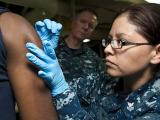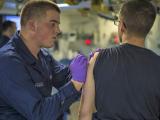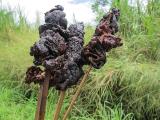Apr 21, 2008 (CIDRAP News) An ongoing trickle of vaccinia virus infections in laboratory workers who handle the virus points up the need for them to be immunized, the Centers for Disease Control and Prevention (CDC) said last week.
Vaccinia is a close relative of the smallpox virus and is the active ingredient in smallpox vaccine. Labs use it in research on orthopoxviruses (the group that includes smallpox and vaccinia) and as a tool to induce cells to make foreign proteins, the CDC said.
From 2005 through 2007, the CDC learned of five vaccinia infections in lab workers, three of whom had never received vaccinia immunizations, according to an article in the Apr 18 Morbidity and Mortality Weekly Report (MMWR). The cases were reported informally, since there is no national system for tracking lab-related vaccinia infections.
The five cases, four of which occurred in academic labs and the other in a government lab, all involved needlestick injuries. Two of the workers were hospitalized briefly, but all recovered. Three patients had a fever along with a lesion at the injury site, while one had only a lesion.
One of the workers had received a vaccinia shot 10 years before the incident, and a second had been vaccinated but had no lesion indicating an immune response. The rest had never been vaccinated.
When the worker who had been vaccinated unsuccessfully had the needlestick accident, he or she bathed the finger immediately in a disinfectant solution. On the same day, he or she also sought and received a vaccinia revaccination, which resulted in a lesion. The worker escaped with no signs of infection from the accident.
Lab-related exposure to vaccinia virus can result in severe or atypical infections, particularly if the dose of virus is large or the exposure involves the eyes, the report says. In addition, recombinant strains of vaccinia commonly carry genes for foreign proteins, which could increase the viruses' pathogenicity for humans.
The Advisory Committee on Immunization Practices recommends vaccinia immunization at least every 10 years for lab workers who handle cultures or animals infected with nonhighly attenuated orthopoxviruses, the CDC reported. Because some lab workers fear that vaccinia immunization will cause side effects, lab directors should provide information about the risks and potential benefits of vaccination, including preventing severe complications of infection, the agency said.
For workers who have not been vaccinated, vaccination shortly after exposure may reduce the effects of infection, the report says.
The article says it is not possible to estimate the incidence of lab-related vaccinia infections, because the number of labs that handle the virus is unknown. The CDC receives fewer than five reports of such cases per year.
CDC. Laboratory-acquired vaccinia exposures and infectionsUnited States, 2005-2007. MMWR 2008 Apr 18;57(5):401-3 [Full text]



















